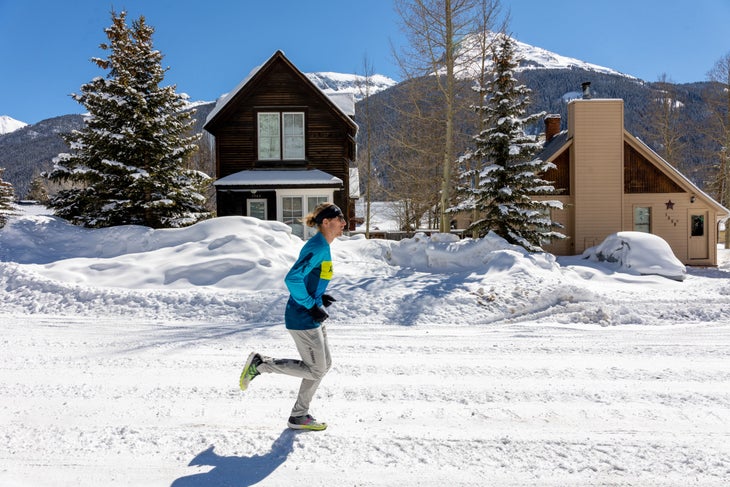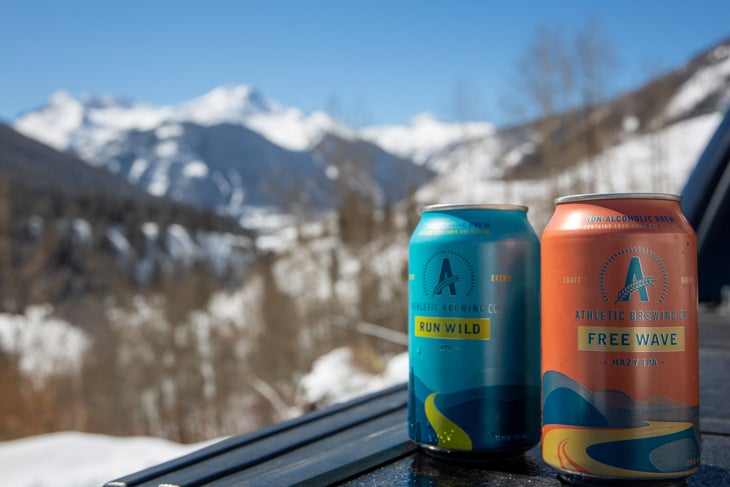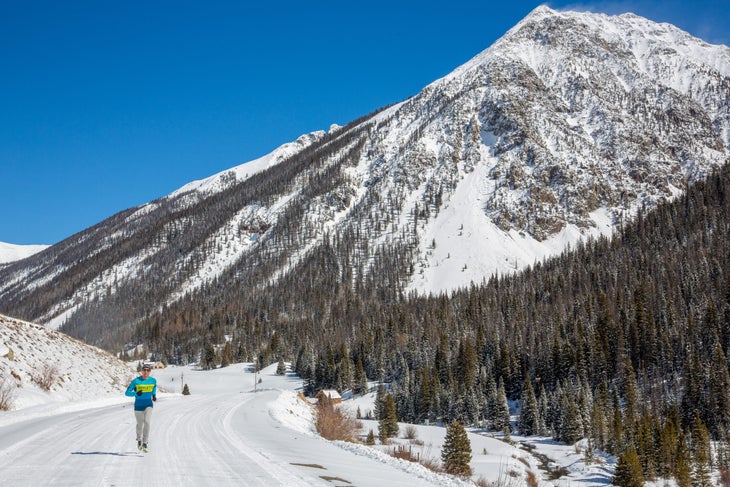Many runners have a list of trail runs that they dream of completing, from a wildflower-soiree on Aspen’s Four Pass Loop or the iconic Enchantments Traverse in Washington State. But the season for these bucket-list runs is short—just a few months—so when the snow starts to melt in the high-alpine, it’s game on. With such a fleeting window of opportunity, how best to prepare your mind and body ready for epic summer missions?
We tapped professional ultrarunner and coach Avery Collin for his best advice. Collins should know—he lives in snowy Silverton, Colorado year round while training for 100-mile races (he’s won the burly HURT 100 and Ouray 100, as well as 50-milers and 50k races)—which means he’s been putting his own advice to the test for years.

Don’t Go the Distance
“In the winter my training is a lot less volume oriented,” says Collins, who often logs 90-100 miles per week during peak spring and summer training. He recommends about a 50% reduction in overall volume during the winter. “It’s just not sustainable to be doing what I do in the summer year round. That’s what leads to burnout.”
To combat burnout, ramp up the cross training and don’t worry about mileage, focusing instead on getting a workout or two done on a weekly or biweekly basis. For Collins, that means running about 40 miles a week and slowly increasing his long run. By late-February he’s up to a 15-miler (his first race of the year is a 50k at the end of May).
Reprioritize Your Goals
Training for long-distance running is time-consuming. Redistribute the free time typically spent logging back-to-back weekend long runs in the summer: reconnect with different hobbies you may have neglected, do that house project, read a few books, or just relax with friends and family. Are you a skier or biker? Spend the winter months focusing on the other activities that you enjoy.
“I use the off season to relax and reflect on the season,” says Collins. That means he’s less concerned (and less stressed) about training and diet, and lets himself indulge during the holidays. “There’s an old saying that the heart doesn’t know what sport you’re doing. If you want to use your weekends to backcountry ski, that’s perfectly fine.” Collins is splitboarder and he takes advantage of his access to the plethora of backcountry touring in the San Juan Mountains a few times a week. Beer culture is heavily intertwined with ski culture, and while Collins is a beer guy, alcohol hinders his downhill performance. Instead, he throws a non-alcoholic Athletic Brewing Co. Golden Ale, which is fit for anytime, in his pack.

Focus on Speed & Strength
Speed and strength are often the first to go when you’re logging high-mileage weeks in the spring and summer, both because it takes longer to recover and it’s more fun to spend your time out on adventurous runs in the alpine. As long as you’re doing one to two easy runs and one speed workout a week, says Collins, you’re doing more than enough. In addition to speed work, Collins does three to four days per week of strength training, typically two days with weight and two days without. His go-to moves are pistol squats, wall sits, single leg glute bridges, and side-to-side lunges. Building glute and core strength is critical for mountain running, especially for people who live in the flatlands. Get out the resistance bands and work your feet and ankles for a few minutes a week, too. “It’s really easy to roll an ankle if that’s not the type of terrain you’re running on frequently.”
Find a Treadmill
“The first question I ask when I bring on new people to coach is: do you have access to a treadmill?” says Collins. He understands that many folks don’t love the treadmill, but it’s a great way to simulate the type of mountain running you’ll be doing once the snow melts. He and his athletes use it once a week for a hill training session. Collins recommends doing sustained grade efforts, starting with 3 minutes at a 3% grade at 50-60% effort with a 3-minute rest period and building on that over time. A treadmill is also a great tool to get miles in when it’s too cold or snowy outside. If you have early summer goals you’ll need to shift from cross-training to reprioritizing running about 16-20 weeks ahead of time to avoid injury. “You want to have a certain amount of bone density from the pounding of running,” says Collins.

Be Flexible
Collins doesn’t just mean this physically, though he does practice yoga 3-5 days a week and focuses on whatever is feeling tight or sore (if you’re a mountain runner, chances are your body is pretty tight). If Collins has a two-hour run planned and a snowstorm hits, he’ll retool his workout and do two hours of strength inside or even go to the sauna. While sitting in the sauna as training sounds too good to be true, it’s not. “It helps prepare for summer in terms of heat training and adaptation,” says Collins. “Also, sitting in a sauna works a heart rate zone that’s very difficult to train (mid-to-high zone 1) because it’s hard to run slow enough to hit it.” And if you’re struggling with burnout—no problem. Collins wants runners to remember that they can train hard without running at all and still maintain a high level of fitness. You can reintroduce running when your motivation returns.
Slow it Down
Have you ever heard of jogging? Embrace it. “For long distance runners, especially ultrarunners, it’s important to be metabolically efficient in low heart rate zones (under 140), so spending 75-90% of your time in those zones is important,” says Collins. If you’re going fast and doing high-intensity all the time you’ll be ill-prepared to crank out a 50-miler where you’re spending five-plus hours on your feet at a lower heart rate. Consider this your permission to keep it easy: go to the sauna, go jogging or walking, go dancing, go skiing, and never feel guilty for taking some time to relax with an Athletic Brewing Co. non-alcoholic beer.